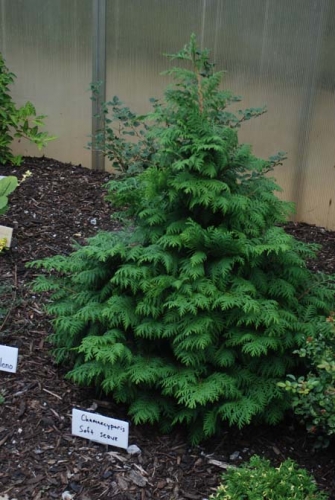Dig in now to plant a living Christmas tree
Plenty of planning and preparation are a must if you’re interested in adding a living Christmas tree to your holiday season and landscape plans.
Green plastic, no matter how you shape it, cannot replace the natural, fragrant beauty of a true fir or blue spruce Christmas tree. However, some gardeners have adopted an “earth-friendly,” holiday tradition in lieu of cutting a live tree for the holiday season by choosing “living” Christmas trees. So, what’s the difference between a fresh Christmas tree and a living tree? Roots, of course!
Many types of conifers can be chosen to grace your home during the holiday season and yet become the next landscape addition in your yard. This may be just the excuse you've been looking for to purchase a dwarf conifer, such as the ‘Soft Serve’ Alaskan Cypress or 'Hoopsi' blue spruce.

Exotic-looking conifers such as the Alaskan Cedar, ‘Soft Serve’
(Chamaecyparis nookatensis) can also make interesting living
Christmas trees.
A living tree can commemorate a special holiday event, family milestone or just become a yearly practice. Families who have been doing this for several years now look into the yard and see significant contributions to their landscape such as a wind break, screen or beautiful addition to backdrop a perennial garden. Living Christmas trees are available from many nurseries and garden centers and may be sold in a large pot or B&B (balled and burlaped.)
Green side up
Choosing a living tree and getting it to survive through the winter, however, offers the consumer a number of challenges. Warm indoor temperatures can break the tree’s dormancy, sending signals to tender buds that it is time to grow. A subsequent January planting will expose those newly unfolding buds to killing winter temperatures.
The root ball itself must remain moist during its stay in the home and may utilize as much water as a fresh-cut tree. One way to avoid breaking the tree’s dormancy is to keep it inside only for a short period of time – two weeks maximum. You may need to buy the tree ahead of time and store it in a cold garage or shed, just until you’re ready to bring it in. If you want to keep your tree in the house until the New Year, don’t plan on bringing it in until December 17. If you’re using a B&B tree, be careful not to drop the root ball or handle it too roughly.
Down size
The second challenge is handling the tree. A large B&B or field potted tree can weigh several hundred pounds. You may need to choose a shorter tree with a smaller root ball just to be able to lift it into your car. Shoppers must stick to the size of tree they can handle, which usually means 3 to 4 feet. (Keep in mind that the pot or root ball will give the tree added height in your living room.) The beauty of choosing a dwarf conifer is that its very nature is small and easier to handle. The top conifer choices are still spruce and the Frazier fir. If you want something out of the ordinary, you could try the 'Hoopsi' spruce with its intense blue color and irregular habit at maturity. Another cultivar of blue spruce is 'Fat Albert,' a cutting-produced clone with a wide, pudgy habit.
Dig in!
The best bet for successful incorporation of your tree into the landscape is to plan ahead for planting now. Dig the hole before the ground freezes and cover it up with mulch, leaves or straw. If you wait, you may need Goliath and a pickax to get it in the ground.
Dig the hole as deep as the root ball and twice as wide. When it’s time to plant, just move the covering away from the hole and fill in with remaining soil. Allow your tree to acclimate to outdoor temperatures gradually by placing it in an unheated garage or shed for several days before planting.
It is best to water the tree at planting time. This will also help eliminate air pockets underneath the root ball. I suggest you finish the job by covering the top of the soil with a 3-inch layer of mulch or compost. Mulch will insulate and protect the roots, allowing them to cool more like normal. If we have a mild winter with little snow cover, I suggest you check your plant to see if it needs water several times throughout the winter.
Many garden centers are handling living trees this year. Be sure to call ahead to check availability. Whether you’re a “tree hugger” or just a “tree lover,” you’ll appreciate the beauty of a living tree that can contribute to the environment, enhance your garden or landscape and establish some new family traditions.
Find out about other educational resources and classes at www.migarden.msu.edu and at Finneran’s blog. You can contact the MSU Master Gardener Lawn and Garden Hotline at 888-678-3464 with your questions.



 Print
Print Email
Email


